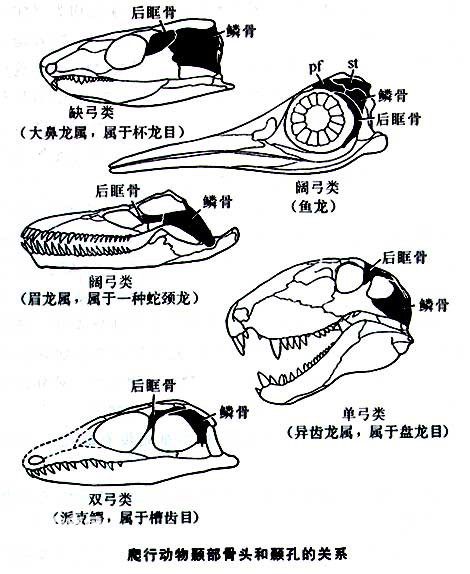Reptiles are the earliest amniotes to appear on earth. They evolved from labyrinths among amphibians. The transition from amphibians to reptiles occurred in the Carboniferous Period, and the transition must have been marked by the production of amniotic eggs. In addition to the most important feature of amniotic egg production and the related development process of reptiles that does not require metamorphosis, reptiles also show many characteristics that are different from amphibians in their skeletal structure.
The skulls of reptiles are relatively tall, different from the usual flat shape of labyrinthine amphibians; some of the bone fragments after the parietal bone become smaller, some move from the top of the skull to the occiput, and some even disappear completely. Most reptiles have only one occipital condyle.
The backbone of reptiles consists of a large lateral vertebral body and an intervertebral body that shrinks into a small wedge shape; in more advanced types, the intervertebral body disappears. Primitive reptiles have two sacral vertebrae, different from one in amphibians; in many advanced reptiles, the sacral bone is composed of several sacral vertebrae, and some types increase to as many as 8. The intestinal bones also enlarge as the sacrum enlarges. Primitive reptilian ribs are continuous from the head to the pelvis and are generally similar; however, advanced reptilian ribs are usually divided into cervical ribs, thoracic ribs and abdominal ribs.
The earliest and most primitive reptiles discovered so far are cuposaurs from the early Permian period. Starting from such a basis, reptiles were unusually adapted to the terrestrial environment at that time because of their evolutionary advancement in reproduction, so they quickly diverged explosively in various evolutionary directions. By the Mesozoic Era from the beginning of the Triassic to the end of the Cretaceous, all kinds of reptiles occupied almost all terrestrial ecological environments on the earth; and some of them returned to the waters and became the overlords of the waters; there is also a group of reptiles Then flew into the sky. Therefore, the Mesozoic Era is the age of reptiles.
According to the development of the temporal part of the skull, that is, the relationship between the development and changes of the temporal foramen, reptiles (classes) can be divided into four subclasses, namely, the subclass Antomys, the subclass Monoscyanus, the subclass Platysus and the subclass Dicysus. .

Temporal foramina of various reptiles
So, what is the temporal foramen? Let us first look at the skull of Cuposaurus. The skull of Cuposaurus is similar to that of its labyrinth ancestors. The top cover is a solid structure, and the only openings on it are the nostrils, eye sockets and pineal openings. Later, with the evolutionary development of reptiles, additional holes usually appeared on the top of the skull behind the orbits, which were called temporal foramina. The function of the temporal foramen is to accommodate the powerful jaw muscles. Therefore, the presence, number and position of the temporal foramen determine the bite method of the animal, which indirectly affects many behavioral and physiological characteristics of the animal. Therefore, it is very scientific to use the development and changes of the temporal foramen as an important basis for the internal classification of reptiles.
Some reptiles have only one temporal hole in the top of their skull behind the orbit; other species have a hole on the side of their skull. Some reptiles have two temporal openings, one on the top of the skull and another on the side. The upper foramen, the superior temporal foramen, is bounded ventrally by the postorbital bones and squamosal bones; while the lateral temporal foramen is bounded dorsally by the postorbital bones and squamosal bones. When two temporal foramen coexist, they are separated by the postorbital bone and squamous bone. The four subclasses of reptiles are divided based on the presence and change of temporal foramen. On this basis, and based on other characteristics, reptiles can be divided into more detailed first-level classification levels.
We created this article in conjunction with AI technology, then made sure it was fact-checked and edited by a Animals Top editor.